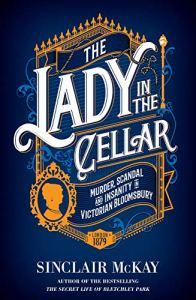 Non Fiction
Non Fiction5*s
So the darker nights have encouraged another foray into Victorian true crime with this, the second book I have read by Sinclair McKay this year.
The Lady in the Cellar refers to a Miss Matilda Hacker who was found amongst the coal in a cellar in a boarding house in Euston Square in London. She’d been dead for quite some time by the time her body was found in 1879 and at first the police were at a loss even as to her identity. You see her final resting place in a boarding house in a fast expanding London lends itself to a more anonymous lifestyle, one where the occupants lived alongside strangers in rooms of varying sizes and facilities.
Matilda Hacker was an eccentric, she’d moved to London from her native Canterbury on her sister’s death – these two spinsters were a familiar site when they took their daily promenade in their lavish silk dresses, dresses which were far too youthful for the ‘elderly’ women who wore them. After her sister’s death she moved away pursued for rates and other bills she could easily afford to pay and took up residence in boarding houses in the capital. The rise of this ‘new’ way of living is expertly explained within the book.
When she came to Mr and Mrs Bastendorff’s bording house it was to be given a furnished room, the use of the water closet and a cupboard to store food and other perishables. She could buy her own food for the servant, Hannah Dobbs, to cook or she could give Hannah to fetch the items herself both means were used to be fed, watered and generally kept an eye on. As Matilda Hacker was in her late sixties by this time, it doesn’t seem to bad a way of life.
We are also treated to the background of the Bastendorffs, the move of Severin from his native Luxembourg to London alongside his sister and a troupe of brothers is also a fascinating insight into how foreigners assimilated into life at this point in history. Severin was a furniture maker who had set up his own business by the time a body was found in the basement of his house. His wife was English and the pair had four small children. This was the rise of the middle classes, the house, the servant and regular income from the business in the back yard as well as the money they made by renting out rooms within their stylish house.
As you can tell there is plenty of contemporary details to be gleaned and Sinclair McKay presents his story well, long before we get to the trial, which lets face it is where the fun begins. The police decided that the perpetrator was Hannah Dobbs, yes the servant! That must have caused more than a little disquiet amongst the middle-classes, no-one wants a murderer living in their home. There were links to pawn-brokers amongst other clues as to what happened to Matilda’s belongings, but the trial was only the beginning.
This was a meaty story with the tendrils once again illustrating that the Victorians were not quite how they have been painted in more recent history. For those of us who were taught they were all prudes, this seems far from the racy story that Hannah sold to the papers! If you want to know more, you really should read The Lady in the Cellar.
I’d like to thank the publishers White Lion Publishing for allowing me to be immersed into this story that ends sadly for more than one of those who, perhaps completely innocently, got caught up in a murder that captured the nation’s attention. This unbiased review is my thanks to them, and to Sinclair McKay for his diligent research which was relayed to this reader in such a well-structured manner that it became a compulsive read.
First Published UK: 6 September 2018
Publisher: White Lion Publishing
No of Pages: 320
Genre: Non FictionAmazon UKAmazon US

